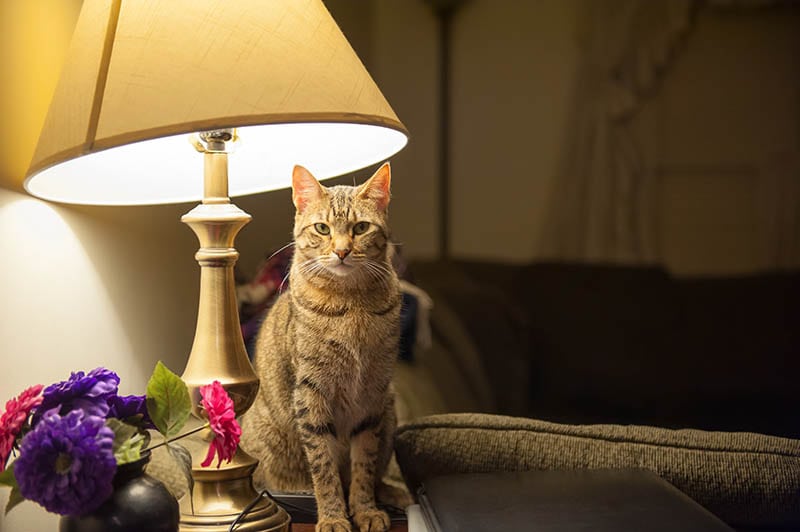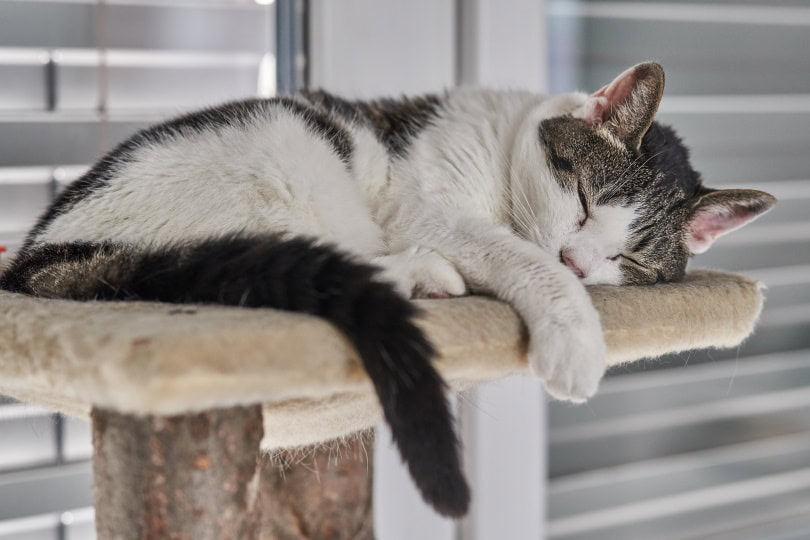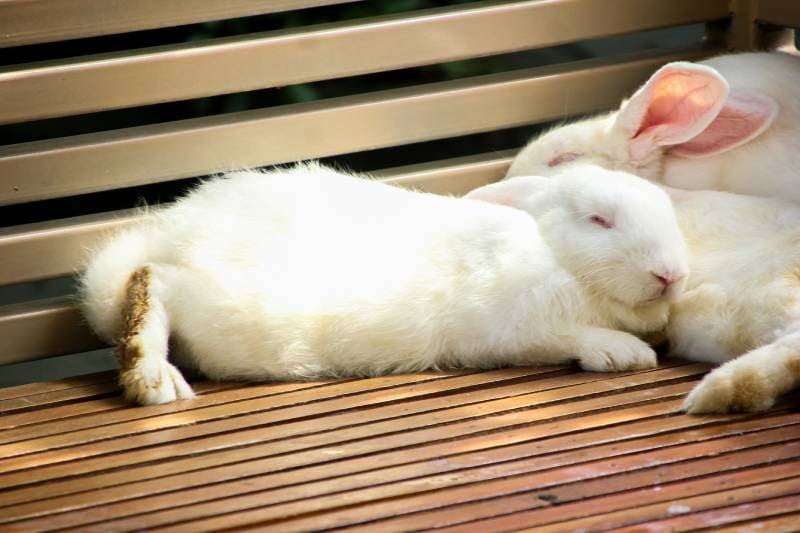VET APPROVED

The information is current and up-to-date in accordance with the latest veterinarian research.
Learn more »Click to Skip Ahead
Cats are often considered mysterious and perplexing because it’s hard to know exactly what they’re thinking or the reasoning behind some of their strange actions.
While we may never know what’s driving these strange cat behaviors or what thoughts hide behind those beautiful, bright eyes, we can take an educated guess. Based on your cat’s behavior, facial expressions, and body language, feline experts can help cat parents deduce their pets’ thought processes.
Keep reading to learn more about how cats think, how to tell what yours is thinking, and what musings may be running around your cat’s noggin at any given time.

Can Cats Think Like Humans?
When we look at the structure of feline and human brains, we can see that they share some similarities. Both species have four lobes in the cerebral cortex, and both brains have grey and white matter. Each region of the brain is connected in the same way. Cats and humans both use the same neurotransmitters to send data. Cats also receive input from the same five senses as humans.
While cats obviously think about various things, the complexity of their thinking process is not on par with humans, according to what we currently know. They probably don’t have a concept of things like the future or past, and their emotions are more basic.

What Does My Cat Think of Me?
Cat cognition is a still-emerging field of science, so we’ll all need to wait for more answers to get a full grasp of how the feline brain works. Until more research comes out, we must rely on information shared by professionals in the pet health world.
Cats communicate in a unique way, using body language, vocalizations, and scent marking to express their needs and emotions, but interestingly, they adapt their interactions depending on whether they are communicating with humans or other cats. For example, cats may meow primarily at humans since adult cats rarely vocalize this way with one another. They also develop individual ways of bonding with their owners, from rubbing against them to slow blinking, demonstrating the complexity of their social behavior.
Research finds that cats respond differently to humans depending on the bond with the human and the person’s behavior. They are capable of reading the human gaze and do so to gauge situations at hand. For example, your kitty might look to you to determine if a current situation is concerning or not.
What’s more, cats don’t only see you as the feeder and poop scooper of the household. Studies suggest that cats display the same distinct attachment styles toward their humans that babies show their parents.
So, despite all the rumors about cats being standoffish and aloof, they’re quite the opposite deep down. Though your kitty may not meet you at the door with their tails wagging like a dog, they do care for you deeply and consider you a part of their family.

Using Your Cat’s Body Language to Determine Thoughts
While you can’t know for certain what your kitty is thinking, you can use its body language and facial expressions to try and figure out what it may be thinking. Unfortunately, studies suggest that untrained humans find it difficult to read a cat’s facial expressions. Try taking this interactive quiz to see how you fare.
Let’s look at some subtle ways your cat may try communicating with you.
Tail
Your cat’s tail says a lot about its mood, so pay attention to what it’s doing throughout the day to get an idea of what mood your cat is in.
| Upright & held high: | Confident, happy |
| Curled top: | Friendly |
| Straight down: | Agitated, aggressive |
| Curved below body: | Nervous, submissive |
| Puffy: | Scared, angry |
| Whipping back and forth: | Angry, afraid |
| Swaying slowly/twitching: | Focused |
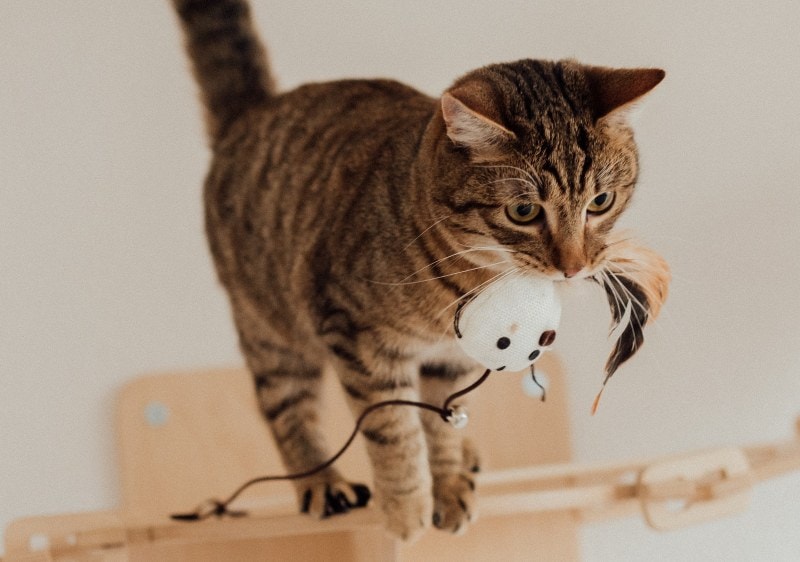
Eyes
The eyes are one of the most expressive parts of your cat’s body and can tell you much about what your cat may be thinking. It’s not only the action the eye is performing that cues you into your kitty’s mood, but its pupils are also expressive.
| Sudden pupil dilation: | strong emotional arousal (e.g., fear, pleasure, excitement) |
| Wide open eyes: | alert, trusting |
| Unblinking stare: | dominance, warning |
| Slit eyes: | fear, aggression |
| Droopy, sleepy eyes: | relaxed, trusting |
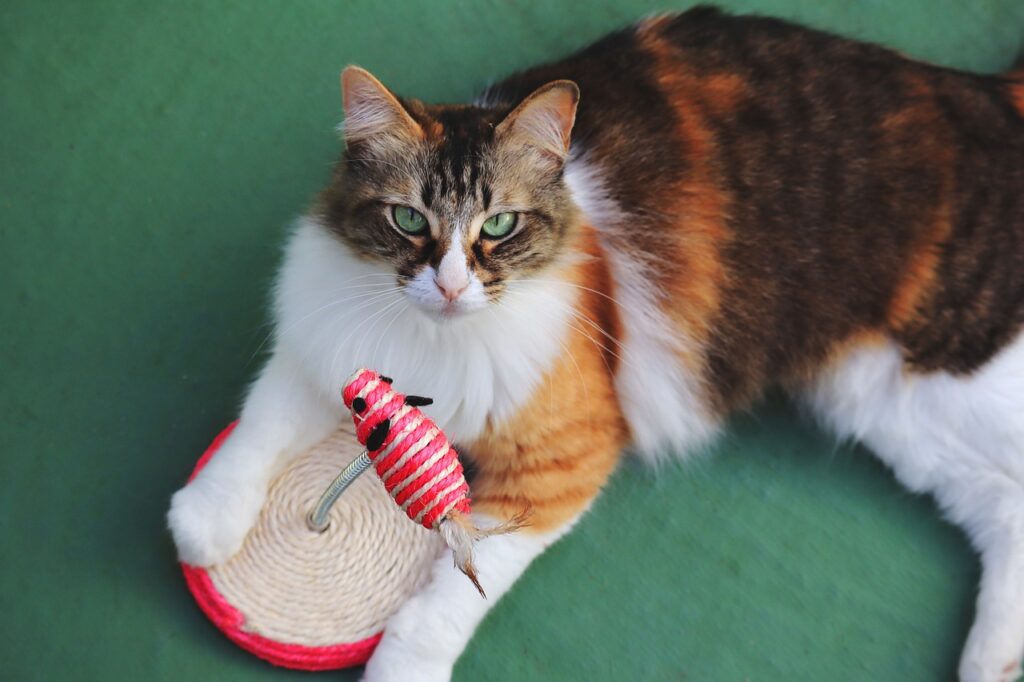
Ears
It’s strange to think of ears as an expressive body part, but they certainly are, at least for cats and dogs. So watch your cat’s ears closely for hints at its current mood.
| Neutral: | happy, relaxed, chill |
| Straight up and forward: | alert, on control, playing |
| Low and sideways: | frightened, nervous |
| Low and facing out: | under the weather |
| Low and flat: | aggressive |
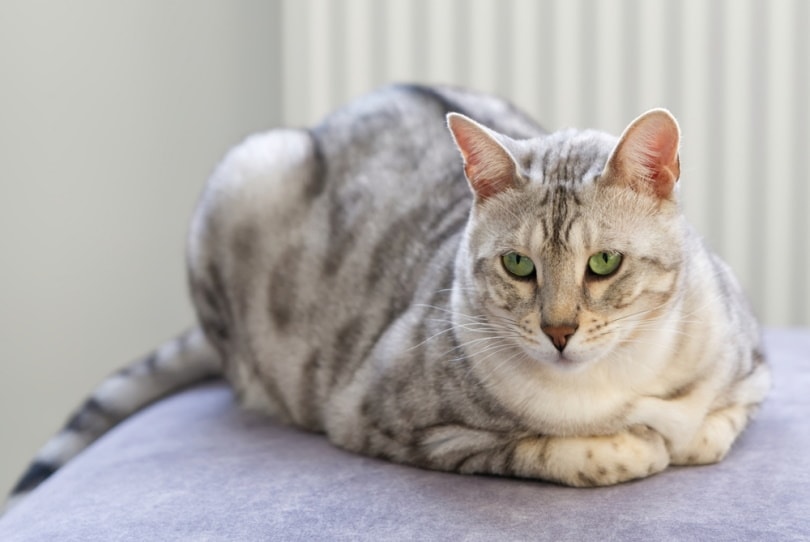
Using Your Cat’s Behavior to Determine Mood
It’s not just your cat’s body parts that can cue you into their emotions. Their behaviors may be the easiest way to determine your kitty’s mood.
- Kneading
- Purring
- Slow blinking eyes
- Drooling
- Whiskers forward
- Playful
- Curious attitude
- Happy meowing
- Snuggling
- Hissing
- Swatting
- Hiding
- Growling
- Biting
- Intense eye contact
- Erect fur
- Hard and focused eyes
- Watching from afar
- Crouching
- Stiff body posture
- Open mouth breathing
- Panting
- Tucked tail
- Pacing
- Hiding
- Hypervigilance
- Excessive grooming

Things Your Cat Thinks About
While your cat’s body language and behavior provide great clues into the mood and thoughts of your kitty, you still don’t know exactly what it might be thinking. Below you’ll find some things your cat might be thinking about during its day.
1. Its Next Meal
Cats love food and can be demanding and purposeful when hungry. Your kitty might spend a good portion of its day wondering when you’ll feed it next, especially if you don’t have a predictable mealtime routine. It might also be scheming how to break into the food cabinet or steal treats.
2. Its Next Nap
Cats sleep an average of 15 hours a day, stands to reason that your kitty probably spends a fair bit of its time thinking about its next nap. Cats can be particular about their napping spot, so your pet might consider where the most comfortable and secure place for its next nap will be.
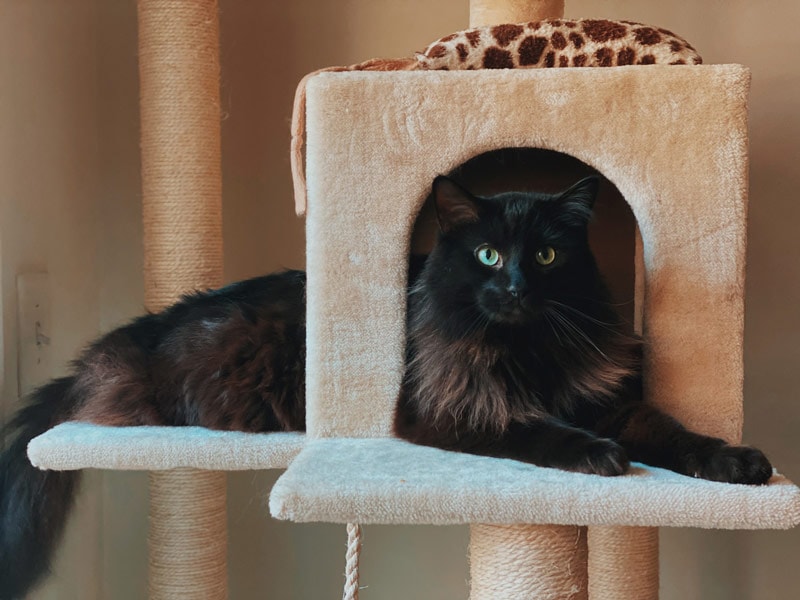
3. Its Territory
Cats are territorial creatures, so your kitty is likely spending some time thinking about its territory. Cats have three types of territories to protect:
- Core: where it feels safe and secure (e.g., sleeping and toileting areas)
- Hunting: where it hunts (e.g., eating and drinking areas)
- Shared/Common: the space it shares with other cats, people, and animals (e.g., hanging out and socializing areas)
Your cat has probably put a lot of thought into the areas it claims as its own, so you may notice it exhibiting natural marking behaviors like scratching or scent rubbing to mark its territory.
The Hepper Hi-Lo Cat Scratcher features a modern and clever design that offers cats an appealing place to scratch – and a way to keep them from scratching all the things they shouldn't. Unlike most cat toys (where your cat probably just prefers the cardboard box they came in), cat's flock to this design ... maybe it's because there's cardboard in it!
With its 3-position setup, textured cardboard, and sturdy frame, it encourages their natural scratching behavior, steering them away from clawing at items like furniture, walls, carpets, curtains, and people. The Hi-Lo is a reliable solution to safeguard your home and create a more enjoyable environment for your cat, all while looking modern and stylish. At PangoVet, we've admired Hepper for many years, and decided to take a controlling ownership interest so that we could benefit from the outstanding designs of this cool cat company!
4. Its Next Hunt
Your cat’s ancestors were hunters, and though your kitty probably doesn’t have to fight to kill its food, it still carries these instincts in its genes. You may notice your kitty at the window “chirping” at the birds when its prey drive is on high alert or stalking its favorite wand toy before pouncing.
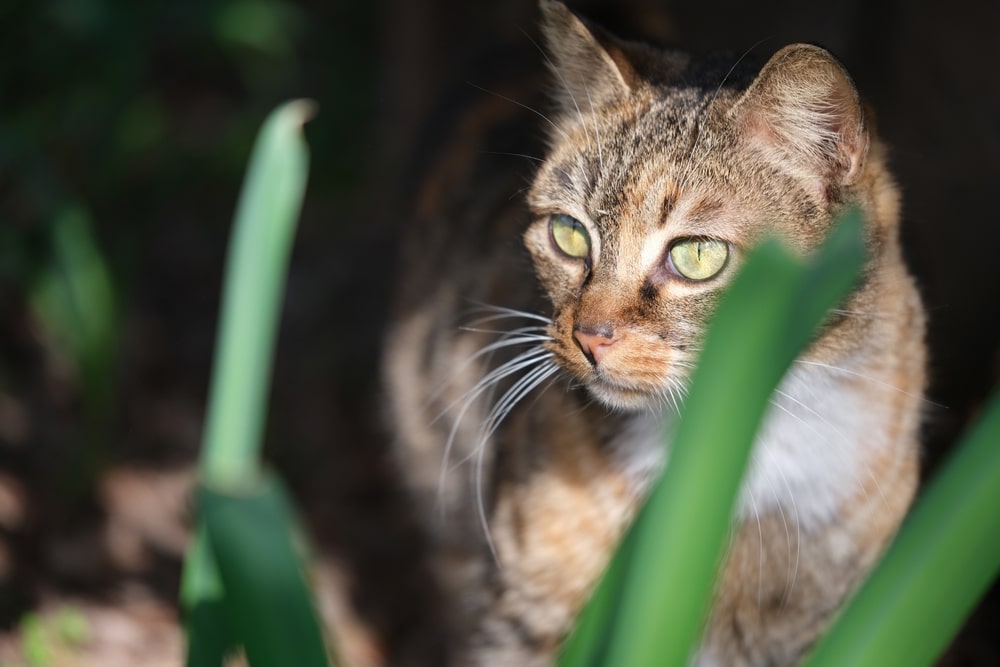
5. You
Your kitty has deep feelings towards you and might spend a good chunk of its day thinking about you or, if possible, being with you. Your cat might wonder where you’ve gone when you leave the house for work or when you’ll lay down so it can snuggle up next to you. If your cat brings you “gifts” like dead animals, it’s probably thinking you’re a pretty lousy hunter or it’s gifting you as a way to show you love.


Final Words
Though we may never know exactly what thoughts race through the minds of our pets, we can use their body language, facial expressions, and behavior to get a good idea of their thoughts and moods. Of course, our cats are probably capable of much more complex thoughts than we give them credit for, but we’ll have to wait for further research to confirm or deny.
- What Do Cats Think About?
- WHAT IS MY CAT THINKING? (YOUR CAT’S INNERMOST THOUGHTS)
- Territorial
- Attachment bonds between domestic cats and humans
- DOES MY CAT THINK I’M JUST A BIGGER CAT? IT’S COMPLICATED
- Paws for Thought: Cat Intelligence
- Angry Cat: 14 Signs Your Cat Is Mad at You
- The Ultimate Guide to Cat Anxiety
- Cat Ear Emotions: How Cat Ears Move With Their Mood
- Cat Tail Language: What Your Cat’s Tail Is Telling You
- Feline Body Language: What Your Cat’s Eyes Tell You About His Emotions
- WHAT ARE CATS THINKING? EXPERTS EXPLAIN 4 COMMUNICATION SIGNALS
Featured Image Credit: Erik-Jan Leusink, Unsplash







